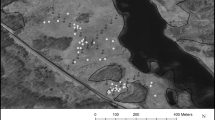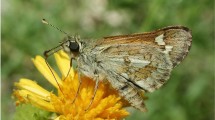Abstract
A tiny (63.1 ha) and uninhabited Nihoa Island within the Hawaiian Archipelago is situated 250 km NW of Kauai. It is a part of Papahānaumokuākea National Marine Monument established in 2006 and jointly administered by NOAA, USFWS, and the State of Hawaii (Department of Land and Natural Resources). The island’s known terrestrial biota include 26 vascular plant species, 27 bird species, and 243 arthropod species. Approximately half of the species are endemic to Nihoa or indigenous to Hawaii. Four plant species and two resident bird species are federally listed as threatened or endangered species. Gray bird grasshopper Schistocerca nitens has occurred on the main Hawaiian Islands since 1964 and was first reported from Nihoa in 1977. In 2002–2004, there was an outbreak of this grasshopper that aggravated the drought and denuded most of the island’s vegetation. Since then, grasshopper numbers crashed, most probably due to insufficient soil moisture for embryonic development. With subsequent rains, the island’s vegetation recovered. During the USFWS expedition to Nihoa in October 2006, grasshopper population assessments were undertaken. Based on 18, 300 × 2 m transect counts, the Nihoa grasshopper population was estimated at 19,430 ± 10,360 individuals. Laboratory rearing of S. nitens revealed that its development occurs without diapause. Potentially, the grasshopper can produce as many as four annual generations on Nihoa, although it is likely that only two generations occur. This article reviews the implications of fluctuations in S. nitens population dynamics for island flora and entomo- and avifauna, in particular, for the endangered endemics, the insectivorous Millerbirds. Potential threats to the island’s biota and challenges for conservation are discussed.








Similar content being viewed by others
References
Anonymous (1965a) Notes and exhibitions for September 1964. New immigrant acridids. Proc Hawaiian Entomol Soc 19(1):27
Anonymous (1965b) Notes and exhibitions for September 1964. Schistocerca vaga (Scudder). Proc Hawaiian Entomol Soc 19(1):28
Athens JS, Ward JV, Blinn DW (2007) Vegetation history of Laysan Island, Northwestern Hawaiian Islands. Pac Sci 61(1):17–37
Beardsley JW (1980) Notes and exhibitions for October 1977. Proc Hawaiian Entomol Soc 23(2):182
Belovsky GE, Slade JB (2000) Insect herbivory accelerates nutrient cycling and increases plant production. Proc Natl Acad Sci 97(26):14412–14417
Belovsky GE, Joern A, Lockwood JA (2000). Grasshoppers—plus and minus: the grasshopper problem on a regional basis and a look at beneficial effects of grasshoppers. Section VII-16 in Cuningham GL and Sampson MW, Grasshopper Integrated Pest Management User Handbook, USDA-APHIS Tech Bull No 1809, Washington, DC, http://www.sidney.ars.usda.gov/grasshopper/Handbook/VII/vii_16.htm
Capinera JL, Scott RD, Walker TJ (2004). Field guide to grasshoppers, Katydids, and crickets of the United States. Cornell University Press, Ithaca and London
Christophersen E, Caum EL (1931) Vascular plants of the Leeward Islands, Hawaii. Bernice P Bishop Museum Bull No 81:1–41
Clague DA (1996) Growth and subsidence of the Hawaiian-Emperor volcanic chain. In: Keast A, Miller SE (eds) The origin and evolution of Pacific Island biotas, New Guinea to Eastern Polynesia: patterns and processes. SPB Academic Publishers, Amsterdam, pp 35–50
Clapp RB, Kridler E, Fleet RR (1977) The natural history of Nihoa Island, Northwestern Hawaiian Islands. Atoll Research Bull No 207, Washington, DC
Conant S (1985) Recent observations on the plants of Nihoa Island, Northwestern Hawaiian Islands. Pac Sci 39(2):135–149
Conant S, Morin MP (2001) Why isn’t the Nihoa Millerbird extinct? In: Scott JM, Conant S, van Riper C III (eds) Evolution, ecology, conservation, and management of Hawaiian birds: a vanishing Avifauna. Studies in Avian Biology, No. 22, pp 338–346
Conant S, Christensen CC, Conant P, Gagné WC, Goff ML (1983) The unique terrestrial biota of the Northwestern Hawaiian Islands. In: Proceedings of the Second Symposium on Resource Investigations in the Northwestern Hawaiian Islands, 25–27 May 1983. University of Hawaii Sea Grant College Report (UNIHI-Sea Grant-MR-84-01), Honolulu, HI, pp 77–94
Culliney J (2004) Nihoa and Necker Islands Expedition, August 27–September 6. An edited transcript of a log of the expedition recorded by John Culliney, Hawaii Pacific University. Personal Observations. Summary of preliminary findings: natural-history, ecology, and taxonomy (unpublished report)
Duranton J-F, Lecoq M (1990) Le Criquet pèlerin au Sahel. CIRAD-PRIFAS, Montpellier and DFPV-AGRHYMET, Niamey
Eldredge LG, Evenhuis NL (2003) Hawaii’s biodiversity: a detailed assessment of the numbers of species in the Hawaiian Islands. Bishop Museum Occasional Paper No 76, Bishop Museum Press, Honolulu, HI, 28 pp, http://www.hbs.bishopmuseum.org/pdf/op76.pdf
Ely CA, Clapp RB (1973) The natural history of Laysan Island, Northwestern Hawaiian Islands. Atoll Res Bull No 171, Washington, DC
Emory KP (1928) Archaeology on Nihoa and Necker Islands. Bernice P Bishop Museum Bull No 53, Honolulu, HI
Evenhuis NL, Eldredge LG (2004) Natural history of Nihoa and Necker Islands. Bishop Museum Press, Honolulu, HI
Fleischer RC, Slikas B, Beadell J, Atkins C, McIntosh CE, Conant S (2007) Genetic variability and taxonomic status of the Nihoa and Laysan Millerbirds. Condor 109:954–962
Gagné WC (1988) Conservation priorities in Hawaiian natural systems. Bioscience 38(4):264–271
Gagné WC, Conant S (1983) Nihoa: biological gem of the Northwest Hawaiian Islands. Bishop Museum News 10(7):3–5
Gilmartin WG (2005) Workshop to identify research and mitigation measures to address Schistocerca Nitens Crisis on Nihoa Island, Northwestern Hawaiian Islands. Honolulu, HI. Hawaii Wildlife Fund, Volcano, HI, April 25–26
Greathead DJ, Kooyman C, Launois-Luong M-H, Popov GB (1994) Les ennemis naturels des criquets du Sahel. CIRAD-PRIFAS, Montpellier, France—CILSS/AGRHYMET/DFPV, Niamey, Niger
Howarth FG, Mull WP (1992) Hawaiian insects and their kin. University of Hawaii Press, Honolulu, HI
IUCN (2007) Orthopteroid Specialist Group 1996. Banza nihoa. In: 2007 IUCN Red List of Threatened Species, http://www.iucnredlist.org
Kevan DKM (1989) Transatlantic travelers. Antenna 13:12–15
Kropidlowski S (2006) Nihoa biological monitoring expedition, April 1–9, 2006. Nihoa Island, Northwest Hawaiian Islands, USFWS-Hawaiian Islands National Wildlife Refuge, Honolulu, HI (unpublished report)
Latchininsky AV (2006) Report of the expedition to Nihoa Island with particular attention to grasshopper Schistocerca nitens. October 11–22, 2006. Report to US Fish & Wildlife Service. Laramie, WY (unpublished report)
Latchininsky AV, Launois-Luong M-H (1997) Le Criquet pèlerin, Schistocerca gregaria (Forskal, 1775), dans la partie nord-orientale de son aire d’invasio—CIRAD-GERDAT-PRIFAS. Montpellier, France/VIZR, St Petersburg, Russia
Latchininsky AV, VanDyke KA (2006) Grasshopper and locust control with poisoned baits: a renaissance of the old strategy? Outlooks Pest Manag 17(3):105–111
Liittschwager D, Middleton S (2005) The Archipelago: portraits of life in the world’s most remote Island Sanctuary. National Geographic Books, Washington, DC
McEwen LC, Petersen BE, Althouse CM (2000) Birds and wildlife as grasshopper predators (Section I-10). In Cuningham GL, Sampson MW (eds) Grasshopper integrated pest management user handbook, USDA-APHIS Tech Bull No 1809, Washington, DC, http://www.sidney.ars.usda.gov/grasshopper/Handbook/I/i_10.htm
Morin MP, Conant S, Conant P (1997) Laysan and Nihoa Millerbirds (Acrocephalus familiaris familiaris and A. f. kingi). No. 302. In: Poole A, Gill F (eds) The birds of North America. The Academy of Natural Sciences, Philadelphia; The American Ornithologists’ Union, Washington, DC
Nishida GM (2001) NOWRAMP 2000 Terrestrial Arthropod Report for the U.S. Fish & Wildlife Service, 30 December 2001, http://www.hbs.bishopmuseum.org/pdf/nowramp2000.pdf
Nishida GM (2002) Hawaiian terrestrial arthropod checklist, 4th edn. Bishop Museum Technical Report No. 24, Honolulu, HI
Oboyski P (2005) A preliminary report from the August 13–20, 2005 Nihoa expedition (unpublished report to USFWS)
Onsager JA, Henry JE (1977) Comparison of five methods for estimating density of rangeland grasshoppers. J Econ Entomol 70:187–190
Predtechensky SA (1935) Studies on the desert locust (Schistocerca gregaria Forsk.) in Central Asia and Transcaucasus in 1929–1930. Bull of Plant Protection, Series I: Entomology, No. 11. VIZR, Leningrad (in Russian with English summary)
Rauzon MJ (2001) The Isles of Refuge. Wildlife and history of the Northwestern Hawaiian Islands. The University of Hawaii Press, Honolulu, HI
Ritchie M, Pedgley DE (1989) Desert locusts cross the Atlantic. Antenna 13:10–12
Rowland C, Jones IL, Swenson C (2007) Nihoa biological monitoring expedition. Nihoa Island, Northwestern Hawaiian Islands, Hawaiian Islands National Wildlife Refuge. USFWS, Honolulu, Hawaii, March 16–25, http://www.mun.ca/serg/Nihoa_tripreport2007.pdf
Song H Weissman DB, Barrientos-Lozano L, Cano-Santana Z (2006) The locust Island. Am Entomol 52(3):168–181
Southwood TRE (1987) Ecological methods, with particular reference to the study of insect populations. Springer, London
Thompson DC (1987) Sampling rangeland grasshoppers. In: Capinera JL (ed) Integrated pest management on rangeland: a shortgrass prairie perspective. Westview Press, Boulder, CO, pp 219–233
USFWS (1984) Recovery plan for the Northwestern Hawaiian Islands passerines. USFWS, Portland, OR
USFWS (2006) Amaranthus brownii. 5-Year review summary and evaluation. USFWS, Pacific Islands Fish and Wildlife Office, Honolulu, HI, http://www.fws.gov/Pacific/ecoservices/endangered/recovery/documents/signedAmaranthusbrownii.pdf
USFWS (2007) Endangered and threatened wildlife and plants; Review of native species that are candidates for listing as endangered or threatened; Annual notice of findings on resubmitted petitions; Annual description of progress on listing actions. Federal Register 72(234), December 6, 2007, 69034–69106, http://www.fws.gov/Midwest/endangered/candidate/2007cnorFR.html
USGS (2006) Translocation Feasibility of the Laysan Teal (Anas laysanensis): executive summary, USGS Pacific Island Ecosystems Research Center, http://www.biology.usgs.gov/pierc/
US NPS (2007) The U.S. World Heritage Tentative list (August 2007 Draft). U.S. National Park Service Staff Report, http://www.nps.gov/oia/TLEssayFinal.pdf
Uvarov BP (1977) Grasshoppers and locusts. Vol. 2. COPR. University Press, Cambridge
Wegmann AS (2005) Preliminary report of the trip to Nihoa in June 2005. USFWS-HINWR, Honolulu, HI (unpublished report)
Wegmann AS, David R, Costa M (2002) Biological Monitoring Expedition: Nihoa Island, September 2–9, 2002. USFWS-HINWR, Honolulu, HI (unpublished report)
Acknowledgements
The author is grateful to all members of the Nihoa team (Beth Flint and Anan Raymond (USFWS), and Kekuewa Kikiloi (NOAA)), for their great camaraderie during our 11 days on the island. I would like to specially thank Beth Flint for her patience, enthusiasm, and infectious fondness for all forms of life encountered during our island adventure. Special thanks go to Cindy Rehkemper (USFWS) for taking care of all our supplies, keeping in touch, and for answering those crazy phone calls from Wyoming. The author is indebted to Mike Richardson (USFWS) for his invaluable help with all aspects of preparation for the trip. Dr. Frank Howarth’s (Bishop Museum) advice and guidance were very useful in dealing with Nihoa arthropod fauna. His colleagues at Bishop Museum, Dr. Neal Evenhuis and Mr. Shepherd Myers were also very helpful. Experience and support of MV Kahana crew and other Kahana passengers was very much appreciated, especially during always treacherous landing on and departing from Nihoa. The author is grateful to Peacock Industries, Inc. for supplying untreated EcoBran® for baiting experiments. Support from USFWS is gratefully acknowledged. Without it, this trip would have never materialized for me. Partial financial support came from the University of Wyoming (Association for Applied Acridology International). The author is grateful to Dr. Jeffrey Lockwood and Ms. Tracy Baldyga (University of Wyoming) for their suggestions on the earlier version of the manuscript as well as to two anonymous reviewers for their constructive criticism. Special thanks go to Dr. Gordon Nishida (University of California at Berkeley) for his most valuable insights regarding the history of S. nitens on Hawaii.
Author information
Authors and Affiliations
Corresponding author
Rights and permissions
About this article
Cite this article
Latchininsky, A.V. Grasshopper outbreak challenges conservation status of a small Hawaiian Island. J Insect Conserv 12, 343–357 (2008). https://doi.org/10.1007/s10841-008-9143-8
Received:
Accepted:
Published:
Issue Date:
DOI: https://doi.org/10.1007/s10841-008-9143-8




